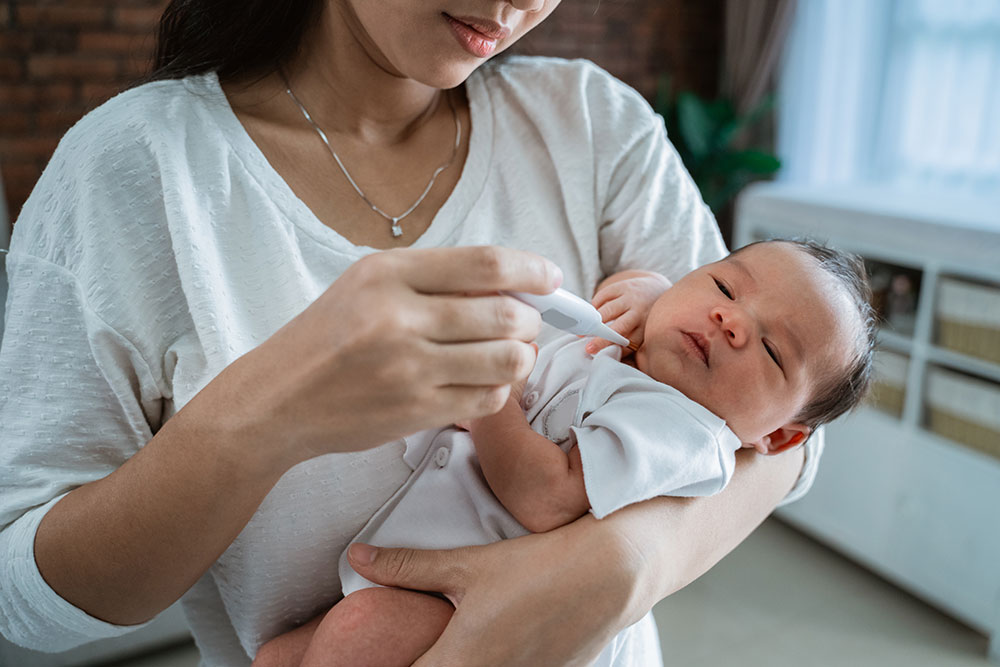What Parents Can Do About the Children’s Medication Shortage

Production of acetaminophen and ibuprofen is struggling to meet the demands of the cold and flu season.
Medical Expert: Jack Maypole, MD
As the nearly year-long infant formula shortage continues in the U.S., parents are now faced with another critical supply issue: over-the-counter medications used to reduce fever and relieve pain in children, specifically acetaminophen (Tylenol) and ibuprofen (Motrin).
In late 2022, a building Tylenol shortage in Canada worsened as influenza, RSV, and COVID-19 spread, heightening demand and exacerbating weakened reserves of OTC medication. Now, parents in the U.S. are experiencing shortages as cold and flu season is in full swing, also accompanied by RSV and COVID-19. This trifecta of respiratory illnesses dubbed a “tripledemic,” has contributed to empty pharmacy shelves across the nation, leaving caregivers confused and concerned.
While the Food and Drug Administration (FDA) has not named a national shortage of pediatric acetaminophen or ibuprofen, experts say an uptick in demand has caused supplies to be inconsistent, if not scarce.
“We can attribute this [issue] to supply chain and production disruption due to the global impact of the pandemic. The shortages of these long-time fever reducers is unprecedented in its extent and scope in my [more than 20 years] of practice,” says Jack Maypole, MD, clinical associate professor of pediatrics at Boston University School of Medicine and member of the educational advisory board for The Goddard School. “Parents may find that grocery stores and pharmacies have little or no medication in stock or are on backorder. It has been incredibly frustrating and difficult to predict where it’s happening and how much longer this will be a challenge.”
If we learned one thing from the formula shortage, it’s that we can’t assume supply will improve anytime soon, meaning a solid understanding of fevers in children is important, and at-home alternative treatments may be necessary. Until product availability can meet demand, our expert pediatrician weighs in on what you need to know about your child’s temperature.
When Is a Fever a Concern?
When your baby spikes a fever, it’s natural to be worried. But an increased temperature is often a natural response to infection and a sign of the body’s immune system working properly.
“Fevers are not inherently bad,” explains Dr. Maypole. “A common saying we use in medicine is ‘treat the child not the number.’ A child’s appearance matters a great deal, especially if they seem OK and are acting normal. Parents don’t necessarily need to give medication just to treat the fever—they can watch and wait.”
According to the American Academy of Pediatrics (AAP), if your child is eating, drinking, and sleeping normally, and they can play, you do not need to treat their fever. On the flip side, if you notice a fever accompanied by other concerning symptoms, including signs of dehydration (dry mouth, sunken soft spot, significantly fewer wet diapers, unable to take fluids), stiff neck, unexplained rash, persistent vomiting or diarrhea, or an appearance of looking very ill or unusually drowsy and fussy, you should call your pediatrician. Dr. Maypole adds that elevated fevers of 103-104 degrees Fahrenheit or higher, and fevers that do not subside with fever reducers warrant medical supervision.
Another primary indicator that a visit to the doctor is needed is your child’s age. “If the child is under 3 months old with a temperature over 100.4, parents should be in touch with a primary care provider (PCP) given their immune systems are still powering up. Similarly, if a child has a chronic or complex illness, such as asthma, heart problems, febrile seizures, or other conditions, parents should also be in touch with a PCP [when a fever spikes].”
While body temperature fluctuates from person to person, the Mayo Clinic deems the following temperatures as fevers in children:
- 3 months or younger: a rectal temperature of 100.4 F (38 C) or higher
- 3 to 6 months: a temperature up to 102 F (38.9 C) with symptoms such as irritability or lethargy, or a temperature higher than 102 F (38.9 C)
- 6 to 24 months: a temperature higher than 102 F (38.9 C) that lasts longer than one day but shows no other signs; if your child has other signs, such as a cold, cough, or diarrhea, you might call your child’s doctor sooner based on the severity of the other symptoms.
It’s also important to note that rectal thermometers provide the most accurate readings for infants and children up to age 3 and should be used when possible.
What Should Parents Do if They Can’t Find Medication?
It’s reassuring to know that not all fevers are a cause for concern, but what about high fevers or the pain and discomfort that can accompany them? After all, getting proper rest is crucial for the body’s ability to heal, but aches and pains from a fever can keep little ones from being able to sleep soundly.
To avoid wasting time, Dr. Maypole suggests ordering fever-reducing medications online when available or calling ahead to check on when pharmacy shipments are expected. Additionally, looking to online communities may be the key to securing needed medication.
“Social media sites can (sometimes) offer good information when communities rally around an issue like this. We saw great collaboration within Facebook groups, for example, that shared crowdsourced information on infant formula during the worst days of the [formula] shortage,” says Dr. Maypole.
While the community effort is certainly admirable, you should avoid accepting or purchasing medications second-hand from anyone you don’t know and trust. Dr. Maypole also warns against looking to social media for at-home remedies for treating a child’s fever or any other ailment. “Parents should be aware of misinformation, as social media can be a place of misleading rumors. Fact-check with reliable sources before coming to a conclusion and be cautious of [popular online] remedies. Don’t just do something because it’s natural or new, and always talk with your provider before trying something alternative.”
Parents should also be cognizant of and comfortable with giving generic Tylenol (acetaminophen) and Motrin (ibuprofen) when they’re able to find them. While each product may contain different packaging, they’re the same medication and can be used interchangeably. However, adult versions of these medications should not be halved or crushed and given to children because it’s difficult to accurately dose OTC medication for kids based on weight by halving or crushing pills. You may also wonder if treating a fever with cold and flu medication is acceptable, but know that it’s not recommended for children under age 12.
Dr. Maypole also makes a critical note that children should never be given aspirin, as it can lead to “a catastrophic reaction called Reye’s Syndrome.” Unless otherwise instructed by a health care professional, don’t give it to your sick child.
Other methods for treating fever include pushing fluids—whether it’s breast milk, formula, water, juice, or popsicles, depending on your child’s age—frequently to encourage hydration, offering snacks (even if your child has less of an appetite, which is OK according to Dr. Maypole), bathing them in a lukewarm bath, and providing cool towels to help lower their body temperature. You should also dress your baby in light, cool clothing for naps and bedtime to avoid overheating and worsening the fever.
Whether treating at home, with or without medication, Dr. Maypole claims it’s important to focus on what he calls “supportive care,” which is any comfort measure (hugs included, he says) to keep your child as content as possible as the fever runs its course.
And while parents should have access to the resources needed to care for their sick children (and to feed them!), there are thankfully additional steps we can all take to keep our families safe.
“The fundamentals medical professionals emphasized during the pandemic are still true here: wash your hands, keep sick kids home from school, and social distance during sickness. If someone in the house tests positive for COVID-19 or has the flu, quarantine based on the current CDC and/or local recommendations,” says Dr. Maypole, adding, “And for those who are eligible, it’s important to vaccinate against all preventable illnesses.”
There’s no official word on when production will catch up to the demand for these products, and the promise of future stocked shelves doesn’t help a parent with a sick child today. In the meantime, remain familiar with fever guidelines and have at-home treatments ready to go. While it’s far from perfect, being as prepared as possible will serve your family better if a sickness strikes.








